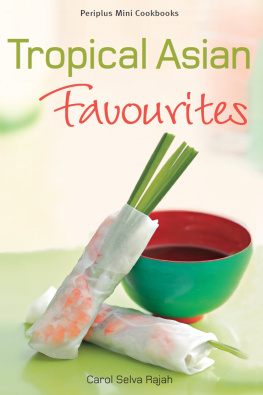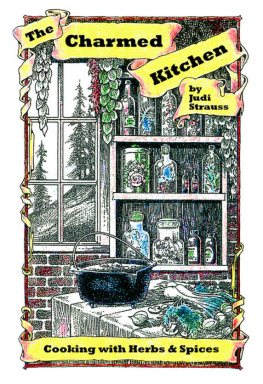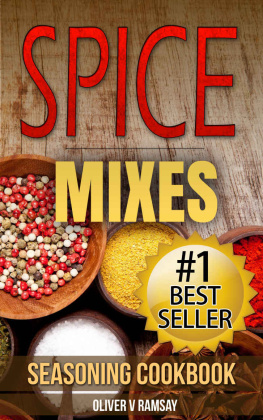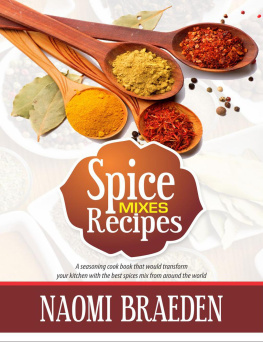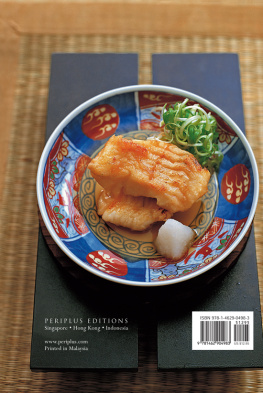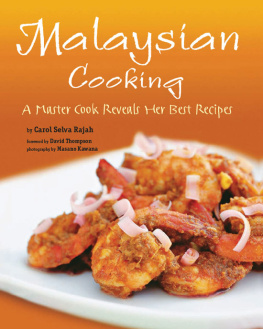ACKNOWLEDGMENTS
This book has been slow-cooking for a long time like any good dish, with spice and herb. Starting as a book on the aromatics of Malaysian food, it contained 90 traditional recipes with a working title we called Ginger Flower.
My daughter Anushiya Selvarajah, a trained teacher of Asian cooking for over 10 years, assisted by Patricia Soosay from Perth, who wanted to gain more of an understanding of Malaysian cooking, tested recipes for months. Both girls knew the food and understood the cuisine just as much as I did, yet we found ourselves re-testing, changing and sometimes reverting to our original recipes in an attempt to improve and to simplify techniques. Finally without any murders or mayhem, the recipes were collated and I thank both Patricia and Anushiya sincerely for teasing out the best flavors with dedication and care.
When it was decided that the book take on a more general impetus with foods ranging from all across Asia, I included recipes from my travels. All Asian food is aromatic, in individual and separate ways. Most include similar ingredients, yet become culinary creations that excite the imagination as different techniques are employed. Thanks also go to Matt Lim, the stalwart in the revival and change of the books direction and to Diane Temple for her careful recipe formatting. The help and friendship of Philippa Sandall, Andrea Rademan and Wendy Lloyd Jones have, as always, been invaluable.
I include some recipes from friends whose work I admire: Lyndey Milan and Di Holuigue, Pauline Loh, Patricia Soosay, Simon Goh and Marty Morrison. I would also like to thank Michelle Sandhu, my niece in Singapore, my brother Abel Arumugam and his wife Gomathy, and Andrea Rademan in Beverly Hills, California, for the use of their kitchens and their computers while working abroad and for their generosity, to Christina Ong for her creative eye and food-styling that has guided the books tone and atmosphere and to Masano for his photography. Thanks also to Dr. Max Lake, OAM . FRCS , International wine judge and author of six books on flavor, taste and aroma. I would not have dared to venture into this realm had I not been convinced of Maxs support and critique; to dear friends Cheong Liew for his support and David Thompson for writing the foreword.
And to Ben Cardillo, for allowing me to see my Malaysia through his eyes, when, in 1991, he wished we had smell-a-vision while we were filming for a television series in Kuala Lumpur.
The following books were used as references:
Spice Notes by Ian Hemphill
Dictionary of Japanese Foods by Richard Hosking
The Chinese Kitchen by Deh-Ta Hsuing
Thai Food by David Thompson
Taste by Max Lake
Sense and Sensuality by Max Lake
Tropical Planting and Gardening by H.E. Holtum and Macmillan, revised by Barlow Enoch and Russel
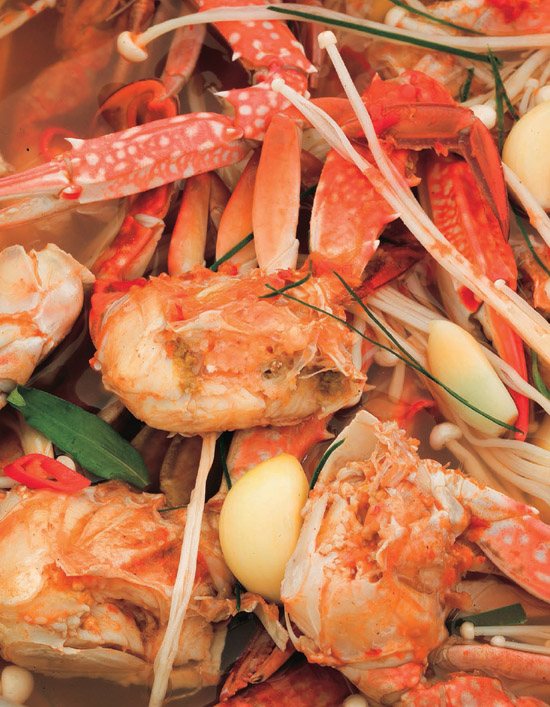

BASIC RECIPES
Basics are just that: simple recipes for cooks that will make life simpler in the kitchen. It is what every experienced cook knows and what every beginner would like to know. I have included simple stock recipes and proportions for pastes and curry powder mixes. It all seems like common sense until you have to do it yourself. I have included instructions for cooking rice as I did not know how to do this, when I was married. I produced a fabulous dinner but had to ask my husband to show me how to cook the riceand he never stopped reminding me about it!
Steamed white rice
Different varieties of rice have different textures when cooked. Jasmine and basmati rice grains are firm and separate while Japanese rice is soft and fluffy. Sticky (glutinous) rice cooks into a dense mass. Before cooking the rice, Asians always rinse it not once but several times, rubbing the grains between their fingers to remove the starchy outer coating on the grains so the rice will be fluffy when cooked.
1 cup (200 g) uncooked short-grain rice
1 1/2 cups (375 ml) water
Place the rice in a large bowl and cover it with water. Stir the rice briskly for about 10 seconds, then hold the grains in on one side of the bowl with your hand and carefully pour away the milky water. Repeat this process several times until the water runs clear, then drain the rice. Transfer the washed rice to an electric rice cooker, add the water and switch on the rice cooker. Fluff the cooked rice with a fork to separate the grains before serving.
If you do not have an electric rice cooker, place the rice and water in a heavy saucepan and bring to a boil over medium heat. Let the rice boil for 12 minutes, then cover the pan, reduce the heat to low and simmer for 1015 minutes until all the water has been absorbed and the rice is cooked. Turn off the heat and allow the rice to sit covered for 10 minutes before removing the lid.
MAKES : 2 cups (200 g) cooked white rice
PREPARATION TIME : 5 mins
COOKING TIME : 15 mins
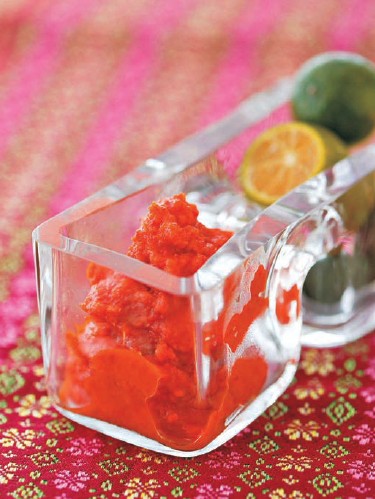
Sambal oelek chili paste
The action of grinding a chili paste is oelek or ulek in Malay. Commercial brands like the Indonesian ABC brand are good, but this sauce is so simple to make that you should try it. If you have a blender it becomes a simple process, but remember to bring it to the boiling point and cool before storing. (see photo above)
1 onion, peeled and sliced
5 cloves garlic, peeled
1 in (2 1/2 cm) fresh ginger, peeled and thinly sliced
12 red finger-length chili peppers, halved and deseeded
2 tablespoons oil
1 teaspoon shaved palm sugar or dark brown sugar
1/3 cup (100 ml) vinegar
1/4 teaspoon salt, to taste
Grind the onion, garlic, ginger and chili peppers in a food processor or mortar to a smooth paste. Heat the oil in a skillet and saut the ground paste over medium heat until fragrant, 35 minutes, seasoning with the sugar, vinegar and salt.
Remove from the heat and cool, then store refrigerated in a sealed jar for up to 2 months.
MAKES : 1 cup
PREPARATION TIME : 10 mins
COOKING TIME : 5 mins
Thai orange curry paste
A versatile curry paste for chicken, fish or scallops. This is a lighter but tastier curry paste which is simple to make especially if you have larger and sweeter red chilies. I would suggest making double the quantity and freezing the extra for later use. (see photo below)
10 dried red finger-length chili peppers, stems discarded, soaked in hot water until soft
1 teaspoon salt
5 small Asian shallots, peeled
1 tablespoon dried shrimp paste, dry-roasted (page 207)
1 teaspoon rice vinegar
Grind the dried chilies in a food processor or mortar until smooth, then add all the other ingredients and grind until well blended. Store frozen in a sealed jar.
MAKES : 1 cup
PREPARATION TIME : 15 mins
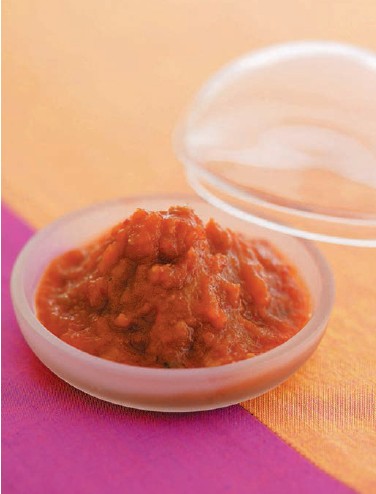
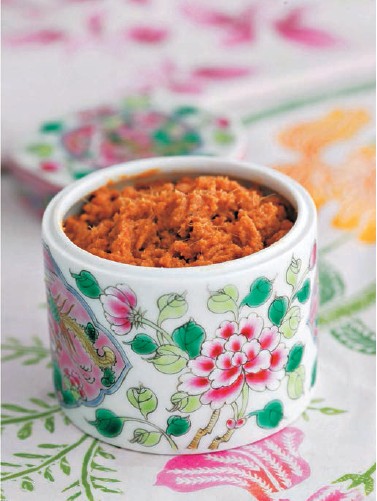
Aromatic nonya spice paste
This curry paste is the classic Nonya standby. Use it as base for many Nonya curries and laksa dishes. Double the quantity as a time-saving exercise and use it as a stir-fry starter for vegetables and soups instead of starting with chopped garlic and onions. (see photo above)



